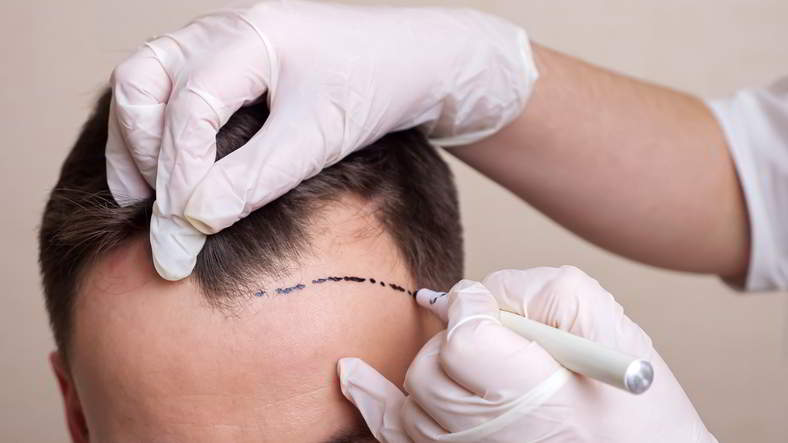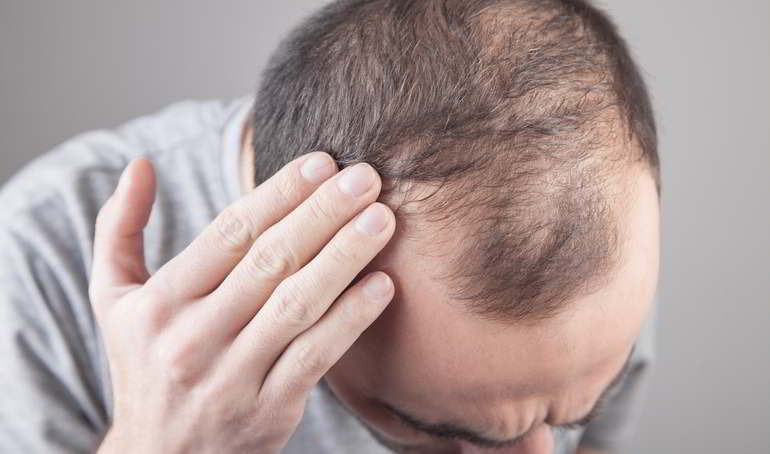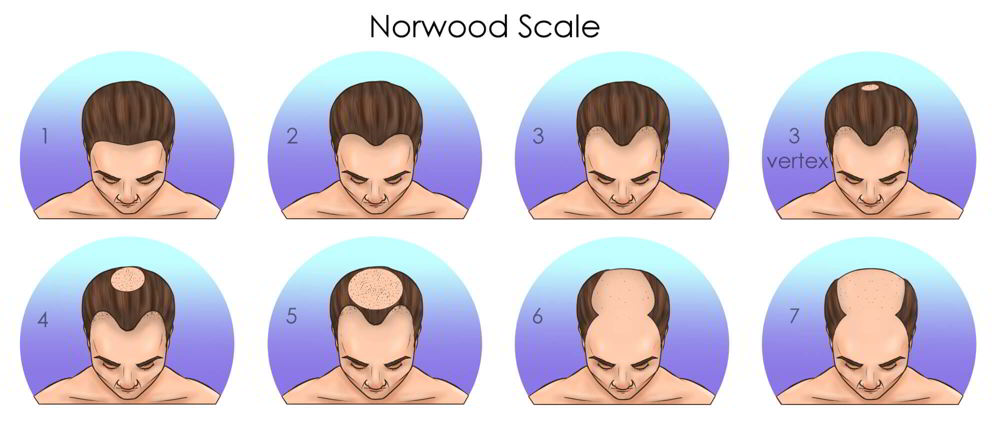Male Pattern Hair Loss
The most common hair loss condition for men is Male Pattern Baldness (MPB). This condition can also be referred to as androgenic alopecia and genetic hair loss. This results in the gradual loss of hair, ultimately resulting in balding. The pattern of hair loss can typically be seen at the front of the head and the middle spreading towards the top area of the head.

What is Male Pattern Baldness?
Malte pattern baldness is a genetic condition that can be passed down from both the mother and father’s side of the family. If someone’s father has a perfectly thick full head of hair, it does not mean they are immune to hair loss but they definitely could be! Male pattern baldness is caused by DHT (Dihydrotestosterone). This hormone is a by-product of testosterone and attaches to the hair follicles of the head. When this occurs, it causes the hair to shrink and become thinner over time until some men become totally bald.
Am I losing my hair?
This question may seem obvious to many, but in reality, most men do not realise that they are suffering from hair loss until it has reached the advanced stages. Advanced hair loss can be reversed with effective hair therapy targeting the strengthening of hair, followed by a hair transplant. Failing to identify your own hair loss is primarily due to denial and the slow-paced nature of hair loss. In modern day lifestyles, men can be so busy and stressed at work that they may simply not even notice their own hair loss. Identifying hair loss at an early stage can be the difference between male pattern baldness and a full head of hair.
How to identify Male Pattern Baldness?
MPB is very easy to identify for someone without clinical experience as it only affects hair on the top of the scalp and not the sides, causing a horseshoe-shaped pattern of hair loss. This can be seen in the form of a receding hair-line, a thinning crown or top area of the head.
If I do not seek treatment, will I eventually be bald?
This depends on a number of factors. Firstly, the condition causing your hair loss – if you have a temporary hair loss condition (which is unusual in men) then the answer may be no. Please refer to our list of other hair loss conditions below if your problem doesn’t appear to be MPB. Assuming your condition is Male Pattern Baldness, the extent of your eventual hair loss really depends. Those men who have a very early or aggressive onset of MPB are more likely to lose their hair more extensively or at a faster rate, which could result in baldness at an early age. We see men who begin to lose their hair at 18 years old (or sometimes earlier). These men will of course be the ones most likely to reach eventual baldness, sometimes at a fairly early age (mid-twenties). Whereas some men only begin to see signs of thinning in their mid-to-late twenties, or even later. These men are much less likely to experience eventual baldness and may just have thin hair by the time they reach old age. The easiest way to tell if you could eventually lose all of your hair is to take note of when the onset of your hair loss began, and how aggressively or quickly your hair is thinning.
Using the right combination of clinically proven treatments should at the very least stop your hair loss, and will usually promote some grade of regrowth or thickening of the hair. This can be both slight or dense regrowth depending on the individual.


When is the best time to seek a solution for my hair loss?
The simple answer to this question is to starts as early as possible. We advise patients that once increased amounts of hair shedding is observed, they should seek advice from a specialist. Male Pattern Hair Loss is a chronic condition that will progress quickly if no action is taken. The more hair that is lost, the less chance your hair will have of making a full recovery, which is why Belgravia specialists always advise using a course of treatment before the condition progresses.
Treating Male Pattern Baldness
Male Pattern Baldness is treated by means of clinically proven medications, laser devices promoting hair growth, micro needling and hair transplant surgery.
There are many products on the market that have no or very little clinical efficacy, this can be an overwhelming process. It is very easy to waste time and money without the proper knowledge whilst your hair continues to thin and shed. It is therefore very important that one books a consultation with a health professional specialised in hair restoration before deciding on the products to treat your hair loss.
The good news is that unless you have lost all or most of the hair from your head, there should be a solution for you. This can be a medical solution, a surgical one, or a combination of the two.
Our all-inclusive hair loss treatment guide explains the most effective options available for treating hair loss along with an in-depth look at the products that may not be worth using.
Will I eventually be bald without proper treatment?
Complete baldness depends on various factors. Mainly, this can be split into two categories; the condition causing your hair loss and the age balding or thinning of hair starts to occur.
In the case of many men, temporary hair loss conditions are very common. This means that the chance of complete baldness is very low, however assuming your condition is Male Pattern Baldness, the extent of hair that will be lost depends on how early or aggressive the onset of hair loss is. Extensive baldness and hair being lost at a fast rate could result in baldness at an early age. The easiest way to tell if you could eventually lose all of your hair is to take note of when the onset of your hair loss began, and how aggressively or quickly your hair is thinning.
If your current hair situation does not appear to be male pattern baldness after referring to the photos and information provided, please refer to our list of other hair loss conditions below.
We strive to provide the best combination of clinically proven treatments that will aim to stop your hair loss and eventually provide signs of hair regrowth or thickening. The results expected can range from moderate to significant regrowth.
When is the best time to seek a solution for my hair loss?
The rule in any aspect of health care is that prevention is always better than cure. We recommended that any individual observing hair loss, makes an appointment and seek advice from one of our medical professionals specialised in hair regrowth. Male Pattern Hair Loss is a chronic condition that will advance rapidly if no action is taken. The more hair that is lost, the less chance your hair will have of making a full recovery without surgery. This is why St Mary’s Clinic specialists always advise using a course of treatment before the condition progresses and to strengthen hair as much as possible before pursuing a hair transplant. This process will improve on the final results.
Will treatment grow all my hair back?
Patients can choose to go through a course of non-surgical treatments involving medical, organic supplements and medical interventions in order to strengthen their hair followed by a surgical intervention. Other patients will go straight towards the surgical intervention and achieve great results in each case.
The clinical data shows us that some men will experience significant levels of regrowth with non-surgical treatment and some more reasonable levels of regrowth. A percentage of users will experience stabilisation and a small number will not notice significant results.
The achievable results can be viewed on our website from our extensive hair growth success stories. Patients should recognise that any sign of response to treatment should be seen as a success. A patient experiencing hair loss stabilisation without any increase in density is also a success, as it is likely that without treatment the hair would have continued to reduce at a much faster rate. Hair loss stabilisation can be followed by a hair transplant to replenish the hair that was lost prior to hair stabilisation.
Patterns of Hair Loss
There are three general patterns of Male Pattern Hair Loss – we are quite confident that one of these will bear a similarity to your own pattern
Receding Hairline
One of the most common patterns of hair loss is a receding hairline, also known as a ‘widow’s peak’. This is where the hair is lost at either side of the forehead, usually leaving a triangular peak in the middle. For some men this might be the only area of hair loss, but others may also experience thinning at the crown. For those with more aggressive forms of MPB the hairline will recede further and further until it either meets the crown (which might also be balding). This may also result in a large bald area at the top or front of the head.
Thinning Crown
Some men will experience thinning at the back or top of the head – called the ‘crown’ or ‘vertex’. This can also coincide with a receding hairline, but sometimes men will only have one of the two. Hair loss at the crown will usually start off with thinning until the scalp becomes visible, after which a bald patch may appear. This bald patch may progress until it meets a receding hairline or causes a prominent area of baldness at the top or back of the head. Again, the extensiveness or pattern is different from person to person, but thinning hair or baldness at the crown is very common.
General Thinning
A less common pattern of hair loss is general thinning, spread evenly over the top of the scalp. Men experiencing this pattern of men’s hair loss will not notice a distinct receding hairline or thinning crown and in cases of general thinning the onset of hair loss may be less obvious and take longer to identify. Thankfully, like the other patterns of male hair loss this form of thinning can be successfully prevented and in many patient cases, reversed. Like all other patterns of Male Pattern Hair Loss, general thinning will not affect the back and sides of the scalp and if you are experiencing hair loss in these areas it will be caused by another condition.
The Norwood Scale
The Norwood Scale is a good visual reference for the progression of male pattern baldness. The scale demonstrates the progression of a receding hairline and thinning crown.

Other Possible Hair Loss Conditions
If none of the above look like your hair loss situation, you may look at our other hair loss conditions page to see if any of the described conditions in this section match your hair problem.
